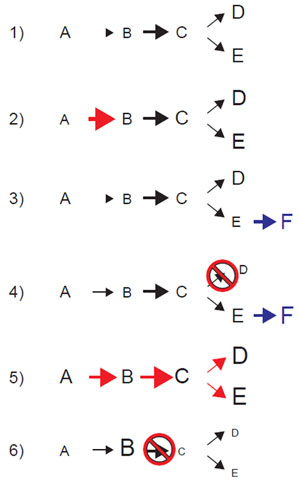Molecular Biology of Plant Pathways / Engineering Formation of Medicinal Compounds in Cell Cultures
Beyond the Obstacles: Molecular Biological Approaches to Improve Productivity of Secondary Metabolites in Plant Cells
After the establishment of genetic engineering techniques, the modification of
metabolic pathways and genetic regulation of secondary metabolism became
feasible. In fact, the industrial production of secondary metabolites is more feasible
if we can improve productivity, either by reducing the culture period or
increasing the level of metabolites (Misawa, 1994). Furthermore, it may be possible
to improve the quality of metabolites by
 |
| FIGURE 11.7 Strategies for overcoming the
limitations in the production of metabolites in plant
cells. (1) Preexisting pathway, (2) overexpression
of rate-limiting (early) step to clarify the regulation
and to overproduce metabolites, (3) creation of a
new branch pathway to produce novel
compound
F and to increase the sink strength, (4) reducing
an undesired pathway to enhance the
metabolic
flow to a desired path, (5) overexpression of
transcriptional factor(s) to activate the
entire
biosynthetic pathway simultaneously,
(6) mutation/downregulation of gene expression
of
biosynthetic enzyme to accumulate the
intermediate of pathway. |
reducing undesired pathways, or
introducing new pathways to produce novel compounds, or by completely blocking a pathway to accumulate intermediates. Such metabolic engineering
would modify plant cells to become ‘‘green chemical factories’’ to obtain the
desired compounds. In the sections below, we discuss how genetic engineering
could be useful for removing obstacles for the production of metabolites in cell
culture or intact plants; general strategies are shown in Fig. 11.7 (also see Croteau
et al., 2000; Verpoorte and Memelink, 2002). One promising result suggests that
transformation itself might be effective for overcoming these obstacles.
C. roseus cells transformed with
Agrobacterium tumefaciens or
A. rhizogenes gave a stable
production of vindoline, which was not found in cultured cells (O'Keefe
et al., 1997). This metabolic activation in transformed cells suggests the possibility that
the cell type-specific expression required for alkaloid biosynthesis may not be
absolutely necessary under all circumstances.